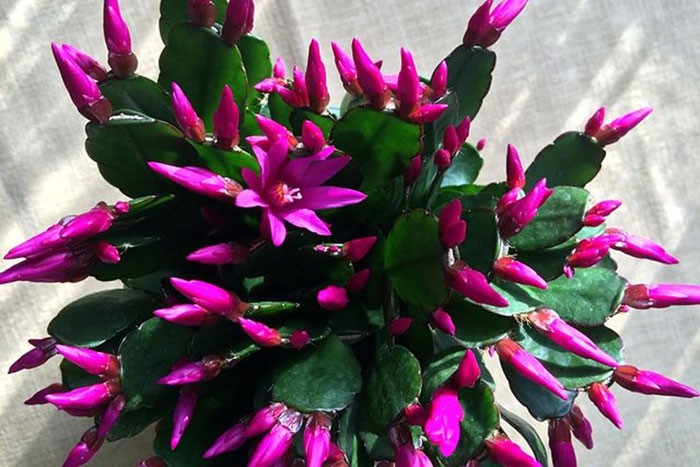|
|
by Cathy Bylinowski, bylinowskic@missouri.edu, MU Extension Horticulture Instructor. Adapted from an article by Dr. David Trinklein, MU Horticulture Did you receive or purchase a holiday cactus as a gift during the holiday season? Holiday cacti, beautiful alternatives to poinsettia, are either Christmas or Thanksgiving cacti. The two are closely related and both are tropical cacti native to south-eastern Brazil. Thanksgiving cacti normally begin flowering in mid to late November and continue into December. Christmas cacti normally begin to flower in mid to late December and continue flowering into January. The stem segments of Christmas cactus are more rounded and do not have forward-pointing teeth. As either plant matures, their branches tend to arch downward resulting in a graceful appearance. The base of older plants becomes thick and woody, supporting the weight of the younger stems and flowers. The flowers of both cacti are similar. Each flower has 20-30 tepals. Tepal is the term used when flower parts cannot easily be classified as either sepals or petals. The outer tepals are short, unconnected and spread out or curve backwards. The inner ones, towards the tip of the flower, are longer and become more fused at the base to form a floral tube. The term "flower within a flower" has been used to describe their appearance. Colors range from deep pink to red and cultivars come in bicolored pink, purple, or red and white. Flowers of the Thanksgiving cactus have yellow anthers (male flower parts that bears pollen), while Christmas cactus flowers bear pink to purplish-brown anthers. Whatever the true identity of your holiday cactus, all require similar growing conditions and cultural needs to thrive and flower next year. Both Thanksgiving and Christmas cactus are tropical, epiphytic (organisms growing at the surface of other plants, soil, or growing medium) cacti and not the "desert types." Therefore, their needs are somewhat different from other cacti. In nature these epiphytic cacti grow in well-drained tree crevices, where decayed bark and leaves accumulate. Epiphytic cacti need growing media high in organic matter with good drainage. Their native habitat is somewhat shady and humid. Although they cannot endure frost, the plants are native to higher altitudes and prefer cool temperatures, especially to develop flower buds. Flower buds will not develop when night temperatures are 70 degrees F or higher for extended periods of time. If possible, locate plants in a cool room or close to a cool window. Never place them near hot air ducts or appliances that produce heat. Flower bud initiation in these cacti is also influenced by the length of day. In nature, they are short-day plants which means they set buds in response to a period of darkness (12 hours or more) each day. In essence, short-day species really are "long-night" plants. At cool night temperatures (50 to 60 degrees F) some flower buds will form even if the plants are not exposed to long nights. For optimum flower bud formation, cool temperatures and natural day lengths (short days) are best, beginning about mid-September. If exposure to these conditions is delayed, flowering also will be delayed. Some reduction in watering at the beginning of bud formation is helpful to promote flower buds. However, plants should never be allowed to wilt. If plants become wilted even though adequate water has been provided, root rot is the likely cause, which results from overwatering. Fortunately, stem segments of epiphytic cacti root easily. Even when a plant's roots have died, these stem segments can be used to start new plants. During summer, holiday cacti can be placed outside in a protected, partly shaded northern or eastern exposure. Properly cared for, holiday cacti live for a long time, producing more flowers each year. They often become heirloom plants that are passed down from one generation to the next. Now is a perfect time to start this tradition in your family. Christmas cactus flowers. Photo credit: University of Missouri Extension
Comments are closed.
|
Categories
All
Archives
April 2024
|
Grain Valley NewsGrain Valley News is a free community news source published weekly online. |
Contact Us |



 RSS Feed
RSS Feed
